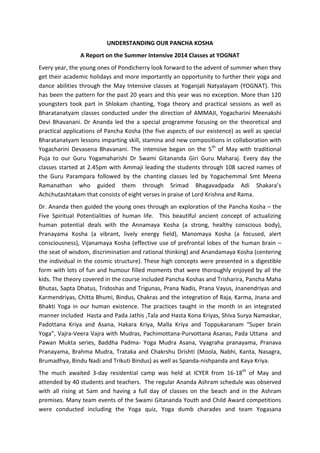The document outlines the 2014 summer intensive classes at Yoganjali Natyalayam, where over 120 students participated in yoga, shlokam chanting, and bharatanatyam under the guidance of experienced instructors. It focused on the teachings of pancha kosha, integrating practical and theoretical knowledge with a variety of engaging activities, including a residential camp and competitions. The program culminated in a valedictory function where students showcased their skills, and awards were given for outstanding participation.




![THE FIVE SHEATHS Taittiriya Upanishad Paraphrased- simplified- abridged by R.R.Diwakar [The spirit is, as it were, encased in five sheaths (koshas), one within the other. We first come across the gross material sheath, and then go deeper to more subtle sheaths, the last being the sheath of joy or bliss. This teaching occurs in the Taittiriya Upanishad and forms the subject of a conversation between Varuna and his son.] Bhrgu was the son of Varuna. He once approached his father and said: “Father, impart to me the spiritual knowledge you possess.” The father said, "Matter, vital airs, eyes, ears, mind, and speech are the things that you daily come across. You must now know that Reality from which all these things issue and live, towards which all these move and in which they finally merge. That is the Brahman. You can know him by tapas or concentration and meditation.” The son obeyed the father and after some meditation came to the conclusion that gross matter itself is the Brahman. He went and told his father so. But the father was not at all satisfied with his son’s findings and he exhorted him to go again and perform more tapas. “Meditation alone will give you real insight,” said the father. Then the son went away and began to meditate further. Next he realized that Prana or the vital power was Brahman and that it was out of Prana that things took their birth and into Prana they finally merged. Prana indeed is the life giving principle. But that too was not a satisfactory conclusion. His father asked him to go into meditation again. He then found that the mind or the psychic plane was the thing from which all manifestation emerged and merged again into it at the end. It was subtler than gross matter and prana and could pervade both of them. He reported this experience to his father. But the father sent him back again with the old advice to perform more tapas. Bhrgu again meditated and found that the power of understanding (vijnana) was the thing from which all things issued and towards which all things moved. But the father was not satisfied and repeated his advice to his son. The son again meditated and finally came to the conclusion that bliss or pure joy was Brahman (Supreme Spirit)- the source and the goal of all creation. All the beings are verily born in bliss, they exist by the power of bliss, and they all move towards bliss and into bliss they all merge in the end. When Bhrgu told his father about this conclusion of his, he was overjoyed and said, “Dear child, this indeed is the highest term of existence. All these five sheaths are there, one more subtle than the other, but the finest and the subtlest is bliss eternal. These are not mutually exclusive. They are inter-penetrating. But the basis of all is bliss, the bliss of Brahman, pure spiritual happiness. He who knows this and realizes it goes beyond all sorrow and death.” This is known as the Bhargavi Varuni Vidya.](https://image.slidesharecdn.com/yognatkoshas2014-140929080314-phpapp02/85/UNDERSTANDING-OUR-PANCHA-KOSHA-5-320.jpg)